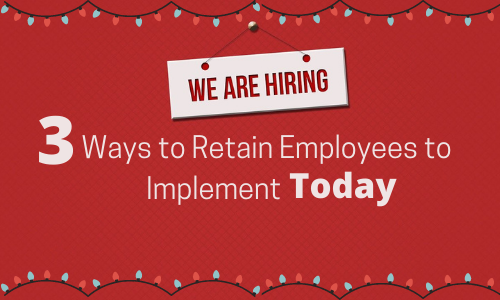How companies are using the reprieve of November and December to prepare for looming January.
The holidays are approaching. Historically, a time synonymous with gift shopping, holiday parties, and time with friends and family, this year HR professionals are celebrating a two-month break from months of steadily exiting employees. November and December are traditionally lower voluntary turnover months whereas the following January traditionally higher. Although many HR professionals will choose to embrace the much needed (and quite frankly, deserved) break from the grind brought about by the “Great Resignation”, many are instead using this time to implement employee retention strategies. A recent 2021 survey sheds light on long and short-term retention strategies that work.
Co-create workplace culture to ensure flexibility.
38% of employees surveyed plan to look for a new job before the summer of 2022. An especially alarming statistic for many HR and talent leaders considering a separate 2021 survey shows 69% of employers report difficulty in filling currently open positions. 30% of those intending to leave their jobs cite wanting more flexibility as their primary reason for looking, making flexibility the #1 reason to seek out new employment, surpassing common leading reasons – higher salary and dissatisfaction with management. As talent teams agonize over the complexities of employee experience design, this call for flexibility suggests perhaps we’re looking to the wrong people to solve workplace problems. Rather than theorizing and convincing employees to buy into our solutions this and other workplace challenges, why not instead empower employees and teams to identify and create solutions? While we tend to believe it’s the highly connected, collaborative teams that effectively solve complex problems, we at Culture Engineered have actually found it to be the reverse. Problem solving, as a team, drives connection and collaboration. Co-creative cultures work because of this principle. Co-created cultures empower employees and teams to identify and solve for external and internal challenges. Because problem solving as a team, and on a larger scale, co-creating, is also associated with higher employee retention, and greater innovation and creativity, it poses as the one stone for the two problematic birds – employee desire for flexibility and increased employee retention.
Promote a culture of gratitude.
How often are leaders thanking employees for their contributions? Although much about the workplace has changed during the pandemic, the power of thanks on employee retention remains the same. It turns out two little words, thank you, have a big impact on retention. 49% of those planning to leave their jobs indicate they have not been thanked for their work contributions in the last month compared to only 26% of those intending to leave recall being thanked in the last 30 days. 2021 survey results combined with those of previous studies suggest employee appreciation, as an employee retention strategy, needs to meet three criteria to be effective:
- Make it count. While 52% of all surveyed workers recall giving thanks to a coworker in the last month, only 34% recall receiving thanks suggesting 18% failed to either recognize or remember being thanked. The best appreciation is specific and done with intention (ie, pulling someone aside or calling someone to say thanks) making it memorable and meaningful.
- Give thanks frequently. Weekly or even daily messages of thanks have shown to impact an employee’s experience and satisfaction significantly. Leaders expressing gratitude when it’s more predictable (annual reviews or Employee Appreciation Day) see less benefits.
- Encourage thanks from every level. Thanks from a direct manager has the most value. But it’s workplaces creating an entire culture of gratitude, enabling kudos and shout outs from all levels and persons within the company (executives, peers, customers, etc) see the biggest impact.
Create an environment where people are seen and heard.
Project Aristotle, a multi-year Google study, was designed to identify why some teams fail while others strive. Findings revealed psychological safety, a team’s collective belief that members are safe to take risks and be vulnerable with each other, to be the #1 factor in team success. Because psychological safety relies on the trust within teams and the willingness of team members to be authentic, psychologically safe environments embolden individuals to see and hear each other. Not only do people perform better in these environments, they turnover less. When we fail to feel seen or heard, we feel invisible and excluded. It’s easier to leave places we believe don’t want us. An employee feeling connected with a team that sees and hears them is less likely to return a recruiter’s call, or peruse job openings.
There are 45 US working days this November and December. The quiet before the stormy mass exodus many predict January 2022 will bring. Although 45 days is not much time, it is a critical time. Holidays can be especially difficult and lonely for many, particularly with the pandemic. Forty-five 8-hour days spent in a humancentric, inviting workplace is no doubt a welcomed change for most US workers. While not every resignation can be prevented, each workplace must distinguish the employee experience key to hiring and retaining those essential for their business. If not now, when?
